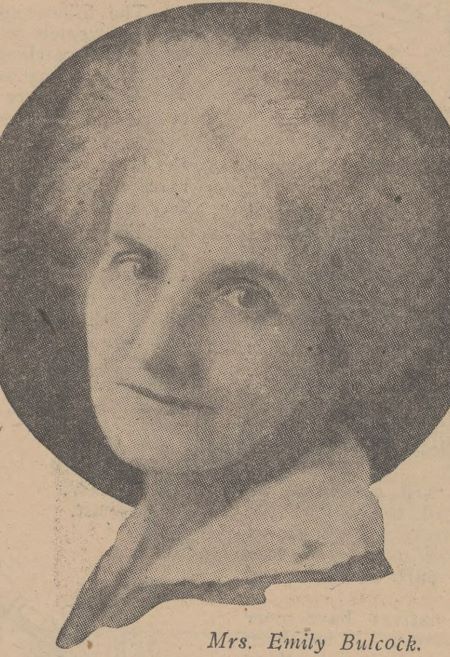Emily Bulcock
A public voice(1877-1969)
For more than 70 years Emily Bulcock devoted herself to the cause of literature. When she died, in 1969, a Brisbane newspaper called her Queensland’s ‘unofficial poetess laureate’[1]. Yet now she is hardly remembered at all. Why?
Bulcock was born Emily Hemans Palmer, at Tinana, near Maryborough, in 1877. Her father was a school teacher, and her brother, Vance Palmer, became a highly regarded novelist. From her late teens, Emily also worked as a school teacher, initially as unpaid assistant to her father (in a class of 90) and then as the first state school teacher at Razorback (now Montville)[2]. In 1903, she married Robert Bulcock. The young couple lived first in the Redlands district, but then, in 1914, moved to Caloundra. Bulcock Beach at Caloundra is named after Emily’s father in law, a businessman and parliamentarian who owned approximately 100 hectares on the beach, which Emily’s husband subdivided in into 400 allotments in 1917[3].
Emily Bulcock began publishing poetry at the age of 12, and by 1898, her work had been accepted for publication in The Queenslander. Her first book of verse, however, Jacaranda Blooms, did not appear till 1923. By then she had become a foundation member of both the Queensland Country Womens Association and the Queensland Authors and Artists Association. Upon her husband’s death in 1924, she immersed herself in literary affairs, serving as committee member and vice-president of the QAAA for nearly 40 years. A second book of poems, From Quenchless Springs appeared in 1945, and a final book, of monarchist verse, From Australia to Britain, in 1961. She was awarded the O.B.E in 1964.
During her literary career, Bulcock was perhaps best known as a public poet. Many of the poems she published were reflections or commemorations of the events of her time. As these events have faded, so has her work. Also, though she befriended and encouraged modernists like James Picot, her own work was rigidly formal and tended to use high ‘poetic’ language, with lots of exclamation marks, and this is not generally to the taste of the readers of today. She married into a strictly protestant family, and a conventional Christian undercurrent is often evident in her verse. This again can tend to make her poetry hard to access in this secular world. As a result, her work was generally overlooked by anthologists, even in her lifetime.[4]
But if you read the poems there is lots of evidence of places and events with which Queensland readers will be familiar, and under an occasionally crusty surface you will often encounter a soft, poetic centre.
‘At Toowong’ is a typical example, from her first book. Written to commemorate the unveiling of the Anzac Memorial at Toowong, Brisbane, in 1922, Bulcock soon enough recalls the young men whom the monument commemorates:
How oft those boyish feet had trod
These very paths along!
Had scaled Mount Coot-tha’s splendid height,
or skimmed with outspread sales of white,
The river at Toowong.
Bulcock’s work is better still when she lets a little of her true self out from under the public persona. So, she celebrates the beauty of a Poinciana Tree in Brisbane’s Bowen Park in blank verse:
And as I share the glow which lights the drabness,
All the protesting puritan in me,
Drowns in this flood of sensuous pagan splendour.
From Poinciana Tree (Bowen Park Brisbane).
Lastly, I like her work when she is contemplating her own place in time. In this poem, she considers the construction of City Hall, Brisbane, in the mid-1920s, before she undergoes an operation:
And as I watched you rise, I felt aghast,
My house of life as surely overthrown… … …
Strange that the thing man made could so outlast
This Heaven-lit masonry of flesh and bone!
From City Hall, Brisbane.
That said, Bulcock is not, even by the modest standards of the Queensland poetry of her time, a major poet. She was important because she helped in the development of an artistic culture at a time and in a place that was decidedly not artistic, and a lifetime after she wrote her best work, her poems are still recognisable and readable. That isn’t too bad, you know.
Best book to buy: Bulcock, E. From Quenchless Springs, Milton, the Author [1945]
[1]‘At 92, poetess’ pen is stilled for ever’ Courier Mail, 5 September 1969.
[2]Puregger, M. Emily Hemans Bulcock in Australian Dictionary of Biography, http://adb.anu.edu.au/biography/bulcock-emily-hemans-5420, accessed 30/9/12
[3]Wagner-Chalazon, A. ‘Bulcock Beach’s rich history’ Salt Spring 2009,http://saltmagazine.com.au/articles_features_bulcock-beach-caloundra-sunshine-coast.aspx, accessed 30/9/12
[4]So far as I can tell, the only non-Queensland anthology in which she was included in her lifetime was George Mackaness' Poets of Australia (1946)

